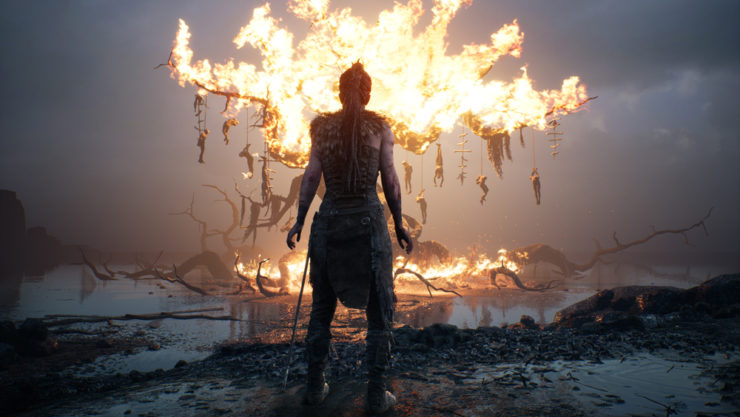I am terminally behind the curve when it comes to popular culture, arriving to everything ten minutes after the zeitgeist. In this spirit, I only played Hellblade: Senua’s Sacrifice, originally released in 2017, this July.
If you are a latecomer like me and have yet to try out the game, I would caution against reading the rest of this article. Hellblade is a great experience, if harrowing, and I’m liable to diminish its effect by spoiling plot points and twists.
Still with me? All right, then.
The story is ostensibly about a Pict warrior, Senua, who travels to the Norse underworld of Helheim to free her dead lover from the clutches of the goddess Hela. Dillion, said dead lover, was violently sacrificed to Hela by Vikings during a raid in Orkney, and Senua is planning to march into hell to negotiate for his release. With his decapitated head tied to her belt.
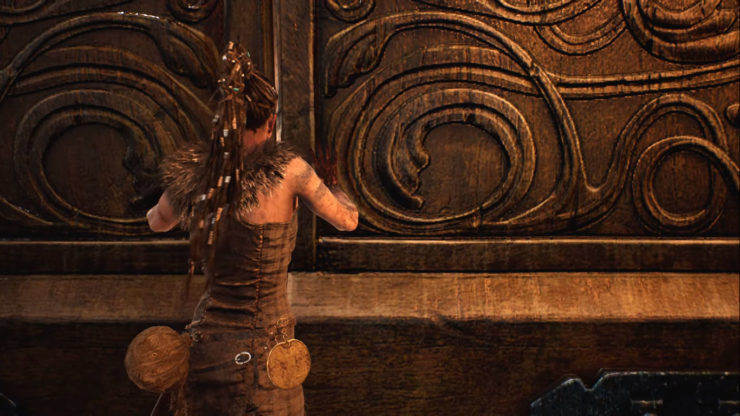
Right off the bat, this is ticking a lot of boxes for me. What can I say? I like a nice hopeless quest into the underworld featuring a heartbroken lover (See also: the plot of my 2019 novella, The Border Keeper.) Thematically, Hellblade is preoccupied with grief and sacrifice, with despair and healing, with guilt and culpability. It goes dark, but does so without cynicism. At its core, this is a deeply earnest game.
Hellblade announces its writing excellence from the very opening. Senua coasts through the mist in a primitive boat, surrounded by whispering. One voice is louder than the rest: it addresses the player directly. “Hello. Who are you? Welcome. You’re safe with me. I’ll be right here, nice and close so I can speak without alerting the others.”
This is obviously not quite as reassuring as the voice might hope, especially as we begin to notice that, oh, there are a lot of dead bodies in the water.
“Look around and you will see them. The drowned, the sick, the slain. Here they lie, rotting in the fields and rivers of Hel. But the dead don’t always lie still here. This is not a place of rest.”
And that line, “this is not a place of rest,” was where I was sold.
Hellblade is ostensibly about a Pict warrior trying to salvage the soul of her dead lover, but it’s also about a broken woman failing to come to terms with the unspeakable horrors of her past. It’s never clear whether Senua’s descent into Hel is literal, imagined, or an awful amalgamation of the two, but it’s entirely real to her. And that, the game contends, is enough for it to matter.
“The hardest battles are fought in the mind,” it refrains.
This story is unambiguously about psychosis—I cannot speak to the clinical authenticity of its depiction, but this was clearly researched and presented with tremendous compassion; and, as a metaphor, it has huge emotional import. Senua seldom speaks, especially in the opening chapters of the game, but she doesn’t need to. The world reflects her trauma back to her; the voices mock, belittle, and chastise her; and she is almost wholly alone except for the Viking berserkers who relentlessly attack her. When the environments turn especially dark, her breathing grows louder and panicked; when she suffers an injury, she limps and gasps with pain. But she keeps going, always.
Senua is not presented as an action heroine, and she doesn’t resemble a conventionally attractive video game protagonist. She’s only a woman—terrified, grieving and overwhelmed— who cannot afford to stop because the person she loves has suffered more than she can bear.
The game leans even harder on the stakes by punishing the player for dying. Every time Senua falls, a creeping necrotic darkness spreads further up her arm. When the darkness reaches her head, the player is told, the quest is failed. Your save data is deleted.
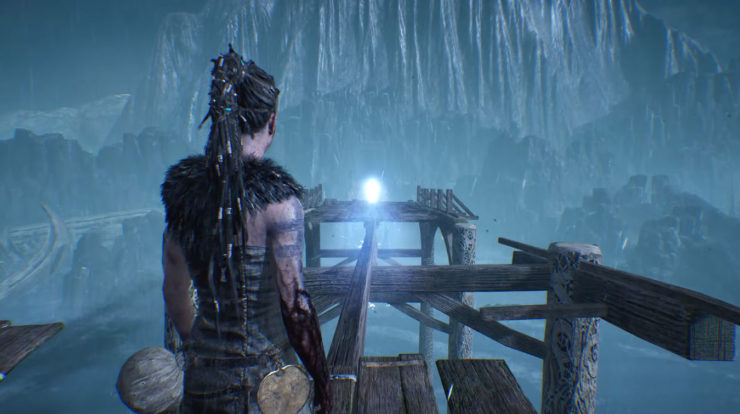
This made me feel irrationally protective of Senua. Not only because of the permadeath threat, but because I didn’t want her arm to get worse. I knew that my mistakes would have a permanent effect on her—and it really bothered me. Coupled with the fact that I wasn’t all that skilled at combat (I never learned to parry; I am of the school of rolling away from things) and we had a recipe for disaster. I felt terrible every time she died, not in a ‘oh, damn, now I have to redo this whole section from the save point’ way, but in a ‘I, personally, am responsible for the continued suffering of this fictional character, and her pain is my fault’ way.
But I, like Senua, had to continue. We were allies in this quest, even if one of us was manifestly incompetent.
Senua’s taciturnity is not shared by the voices that haunt her, and as the story progresses it becomes increasingly clear that the majority of these voices are a distorted reflection of her own thoughts. This is at once an obvious conclusion and a heartbreaking recurring realisation—the whispers that she is stupid, that she is worthless and cursed, that she is responsible for the atrocities that befell everyone she met, that no one will ever love her again… that’s not an external force tearing her down. That is what Senua is, in every silent moment, telling herself.
It’s an ingenious piece of storytelling, because the disjunction between her fierce quietness and the utter self-loathing conveyed by the voices’ debasement of her character speaks to her suffering in a way that would be impossible to express directly. By not saying: “I am the reason Dillion is dead, I feel that I killed him,” the game refutes any notion that Senua might be self-pitying, hyperbolic, or seeking validation through the potential for disagreement—it feels more honest, because the voices exist outside her control or ego.
Simultaneously, when she snaps back or occasionally tells the whispers to shut up, you have the sense that she is desperately resisting her own self-condemnation. It’s altogether more complicated than simple acceptance of her responsibility in Dillion’s death. This is an ongoing battle, and one that the player cannot help Senua win—even though it is crystal clear that she is not the villain of this tragedy, but one of its victims.
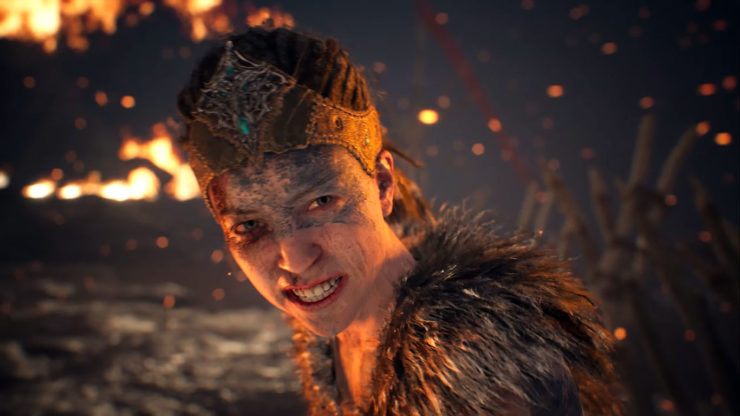
And that’s a huge part of the narrative journey of the story: Senua’s painstaking and hard-won realisation that she was not to blame. That her ‘darkness’, her ‘curse’ of psychosis, was never the cause of the calamity, nor even an inherent flaw in her character.
Through flashbacks, whispers, and the dreamscape environments she traverses, the player steadily pieces together her history—we learn of her dead mother, Galena, who shared the same ‘curse’ but instead viewed those voices and heightened perceptions as a gift. We witness the slow development of Senua’s relationship with Dillion, and how the world came alive in his company, how he gave her a confidence and resolve that she could not have imagined. We flee through a festering plague village, pursued by a furious but invisible force that ascribes the sickness to Senua’s influence. We see the hillside of corpses after the Viking raid, with Dillion’s body blood-eagled at its summit.
But even as we progress through this abject horror show, there are these tiny disorientating moments—little mentions and allusions growing ever more frequent. To Senua’s father, Zynbel. The man who tried to contain her darkness. To cure it.
From the start, you just get the sense that Senua is shying away from thinking about him. Because wasn’t he right in trying to fix her? Because if she had followed his strictures and guidance, submitted herself to the gods, couldn’t this all have been prevented?
And then you realise that one of the voices—the only male voice, the sometimes-paternalistic, sometimes horrifically cruel voice, the only voice that is markedly not-Senua, the voice of ‘the shadow’—is Zynbel. And a rather different picture of events begins to emerge.

Senua might have always seen the world differently, but the game very deftly implies that her darkness was not the product of her mental illness, but of the abusive treatment she suffered in the name of curing it. It is powerfully gratifying to watch Senua realise this, even in a backsliding, sporadic way. Her psychosis, it is suggested in the climax of the game, originated in the deeply repressed trauma of witnessing Zynbel murder her mother. With Senua present, he burns Galena at the stake to purge her of the darkness.
It’s a vividly terrible scene, even in a narrative this dark, and one which brings earlier elements of the game into new relief. The scenery of Helheim features, again and again and again, burned corpses on stakes—and now we see that this is not merely grotesque decoration, but a recurring, inescapable, return of the repressed in Senua. The player is at one point actually forced to look at a charred corpse on a cross to solve a macabre visual puzzle; we see it and are disturbed, but the underlying significance of the image eludes us until Senua can recall her past.
More details stand out—the regular inclusion of dead bodies in cages and cells evokes Senua’s own torturous confinement. The gigantic, looming face of the goddess Hela is not half-rotten, as Norse mythology and the game itself declares, but on closer inspection half-burned. Burned, and on the same side as Senua’s recollections of her dying mother. Two of the named enemies that Senua must overcome are Surtr and Valravn; the god of fire, and the god of illusion, one for the trauma of her loss, one for the inability to recognise it.
At every turn, the truth is present in the hallucinatory visual landscape of the game; but we, like Senua, just aren’t at the right angle to see it yet.
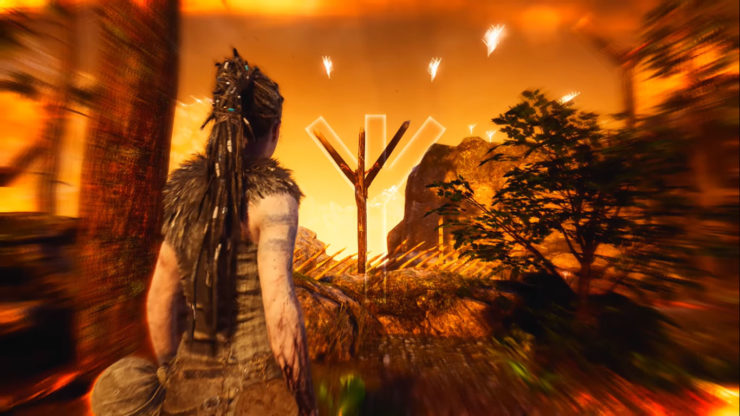
This is a story that moves backwards as it moves forward, with the past ever-intruding on the present. It’s a story where external violence is contested on the battlefield of internal wounds, and where reality is malleable in some regards and devastatingly fixed in others. Dillion loved her, Dillion is dead. Galena is free from her ‘curse’, Galena is dead. All the worst parts are true. The things we wish were imagined are real, and there can be no fixing them, even though Senua tries, even though so much of what she experiences is uncertain.
Before the final battle, there is a brief cutscene that is unlocked by discovering all the collectibles in the game. It isn’t long or dramatic, and seems rather underwhelming given that a player has to find 44 easily missable shiny rocks just to see it. But it contains one key piece of information—a man in black willingly led the Vikings to Orkney, resulting in the slaughter.
Despite blaming herself for the raid, Senua is not a man in black.
But her father most certainly is.
Armed with both this knowledge and the full recollection of what happened to her mother, she moves to confront Hela. Zynbel’s voice continues to berate her, but this time Senua rejects his poison with screaming defiance. Hela looms over the scene, the goddess at once representing Zynbel, Galena, and Senua herself, and we charge forward to meet her.
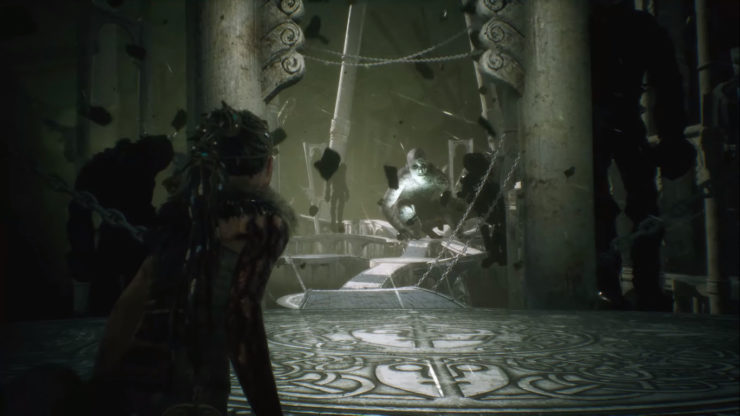
What follows is almost euphoric. The music swells unexpectedly, driving forward with a powerful beat and ethereal vocalisation, nothing like what has come before. As hordes of Vikings materialize in Senua’s path, she continues to run. Until now the combat has felt relentlessly punishing, but this time Senua is stronger; every time she stumbles, she gets up again immediately. The voices that have mocked her for the entire journey are reduced to one, and it is kind; it is gentle and soft-spoken, a whisper that cautions and encourages, unquestionably on her side.
It’s impossible to ignore the changes, and it made for one of most strikingly moving gameplay experiences I’ve ever had. There are many games with affecting cutscenes, but there are very few occasions where every element of the gameplay itself is engineered to generate an emotional response. You can feel that Senua has reached her limits. With nothing left to lose, she throws herself into battle with furious abandon, and the effect is liberating and devastating in equal measure.
When we finally reach the platform that Hela occupies, the goddess has shrunk down to human size. Wave after wave of enemies assault Senua, each faceless assailant followed by another. And eventually you realise: there is no end to this. More nightmares will always replace those that fall. You cannot reach Hela, you cannot win. All you can do is… stop.
Stop fighting.
It’s the last thing I wanted to do. By this point, I was 100% ready to bludgeon every Viking in Scandinavia to a pulp for my long-suffering warrior woman. We were going to resurrect Dillion, and then we were going to send Senua off to live in a nice house with her nice boyfriend, and maybe invest heavily in some much-needed therapy for both of them.
But the lone remaining voice was asking her to stop, and by now I had worked out that this voice probably belonged to Galena. “Let go of your battle. You don’t have to fight anymore. Let go of Dillion. You’re killing yourself.”
Dammit, Hellblade.
Because, of course, Senua can’t live while bound to the grief of losing Dillion; she can’t shed the delusions of her psychosis while clinging to the lie that he could be restored to her. She cannot win the fight without conceding to the truth that he is gone.
To the last breath, however, Senua refuses to reconcile this knowledge; if she keeps the darkness alive, she keeps Dillion alive. In response to her denials, the expressionless and silent Hela ultimately kills her. As Senua collapses, she hears Dillion speaking to her again. In her mind they lie palm-to-palm; as she fades, they are finally reunited.
The view shifts away from Senua’s body, and settles on Dillion’s skull as Hela picks it up. The goddess’s appearance is unearthly and disfigured; it makes her expression hard to read. She walks toward the player with the skull held like an offering. Her face is moving; she stares at the clothsack-wrapped head in her hands and her mouth crumples. Her face is so strange, but it looks like she is weeping. She sinks to her knees, and she seems to be speaking to the skull although we cannot hear her words. She rocks back and forth a little, then leans forward over the misted abyss before her, and gently lets the skull fall.
She lets him go.
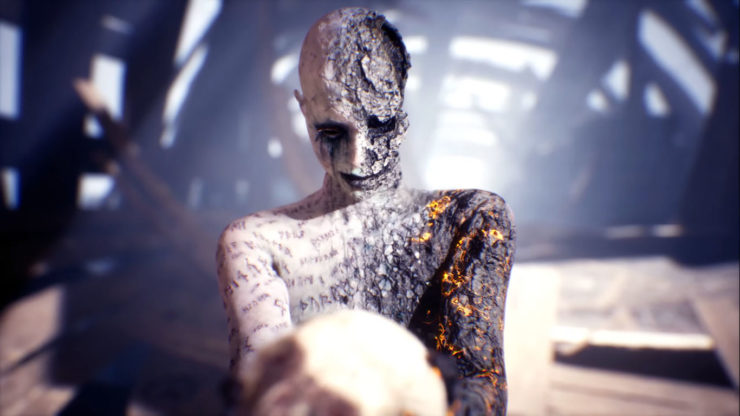
The view lifts and Senua is kneeling in Hela’s place.
“Goodbye, my love,” she whispers.
I think there’s something miraculous about storytelling that feels like both an inevitability and a surprise, to art that summons sweetness from the heart of grief. This was the moment that the whole game had built towards. Yet I did not see it coming. Yet it was exactly right. When the view pulls back further, we can see that Hela’s body now lies where Senua had died. The darkness was defeated, in the end, but even victory could not mend what had already been lost. Senua can only move on to the next story. But that is not nothing.
As she studies the landscape, the whispers return. They had to—profound mental illness is not magicked away by battling an army of Vikings and the queen of the underworld. But the voices are different now, no longer malicious, and Senua’s rotted arm is healing. She has made some kind of peace with herself.
Hellblade is a brutal game, but an undeniably beautiful one. It’s uncommon, for me at least, to feel so profoundly enriched by the experience of a story. I believe there is a sequel in the works, for which this absolutely batshit trailer exists, in which Senua sings catchy Icelandic deathmetal? (Please be aware that the video features, amongst other things, a rack of hyper-realistic dismembered arms swaying in the wind.)
But even without the exciting prospect of Senua’s journey continuing, Hellblade stands alone as a testament to brilliant game writing and design. The hardest battles are fought in the mind—and it will be a long time before this one leaves mine.
Buy the Book
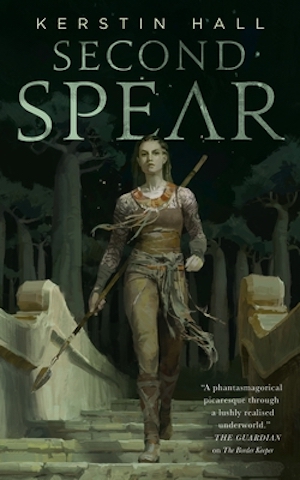

Second Spear
Kerstin Hall’s short fiction has appeared in Strange Horizons and Fireside, and she is the author of the novella The Border Keeper. She lives in Cape Town, South Africa. You can find her on her website and on Twitter.










